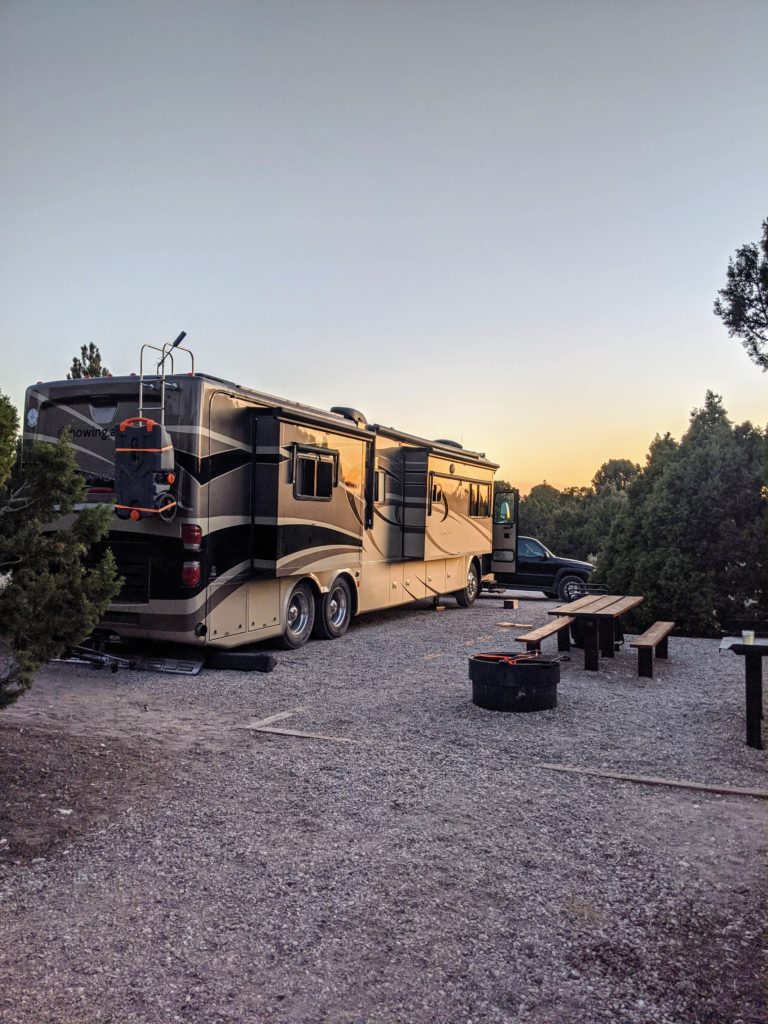As our friend Steph once asked after we explained how we live in a motorhome about two years ago while we sipped wine in a dog-friendly winery, “but where does the poop go?”
If there’s anything not exactly great about this whole RV life, it’s how close I come to my own feces on a semi-regular basis. I guess all that work in the plumbing industry was foreshadowing.
I’m over here making myself laugh with poop jokes while Jeremiah just shakes his head. What can I say? It takes all kinds.
Monthly campground without hookups
We are in a campground right now where we are renting a monthly spot outside of Chattanooga, Tennessee. Winter travel during a pandemic, as I’ve mentioned before, is hard. Kicking our feet up and not traveling was our best choice right now. We have space and pretty views from our campsite, but what we give up is that we don’t have septic at our site. We have a couple of options. 1. Skip doing laundry and only make one-pot meals to save on dishes, and limit our showers so we only have to dump infrequently. 2. Use the campground bathroom to further conserve water. 3. Conserve where we can, but continue having relatively clean clothes and dishes, and cooking and eating as we normally do. We’ve chosen the last option, and so we have a poop caddy.
I’m sorry, what did you just say?
Oh you know, a barrel we pump our black and gray tanks into, that we then truck up the hill to the dump station.
You know that’s not exactly what it is, but it explains it more or less.
Here’s a picture of it on the back of our rig.

The black tank-gray tank-caddy process
The benefit of having this is we don’t need to fold up our entire house, detach from electric and water, and drive it across the parking lot each time our tanks our full. The downfall is that I get to truck a container of 30 gallons of dirty water behind our Tahoe every week or so. I do this several times in one day, typically the morning. You know, when it’s cold and things don’t seem to smell as bad. I would describe the smell, but you don’t really want to know, do you? Okay, okay, if you insist: it smells like Chinese food every time.
What’s the actual process of dumping into a portable waste holding tank? It’s simple.
- Gloves on.
- Sewer hose into the holding tank
- Open whichever tank we need to dump.
- Turn on the macerator. (Our water bay is actually really fancy – most RVs don’t have macerators, but it means things will never get clogged.)
- Fill the holding tank.
- If we dump the black, we always rinse the black with soapy water from the grey tank.
- When the caddy is full, I attach it onto our tow hitch on the Tahoe. This is the hardest part for me, because 30ish gallons of water is heavy.
- Drive slowly to dump station.
- Take the 240 pound caddy off the hitch.
- Hook up sewer hose to dump.
- Attach other side to caddy.
- Open caddy where hose is.
- Dump.
- Rinse everything.
- Drive back with empty caddy.
- Repeat.
Depending on how much I rinse and backwash everything, each individual run takes between 10 and 20 minutes.
Is boondocking different?
Our approach to staying in a monthly spot with no septic, but with a dump station, is different than how we approach boondocking. In the middle of the Utah desert as an example, we gave up laundry, ate simply. Don’t ask us how often we shower when we boondock. (Hey, dry camping isn’t for everyone. I get it.) We can “comfortably” boondock for two weeks before we need to fill up on water or dump our tanks. However, if we know there’s a dump tank less than a quarter mile away, we live recklessly, cooking meals and taking showers every 3 days.
RV life is fun. It really is. I don’t even really care about the dumping of the tanks. I mean, until my gloves ripped last week. Every thing has an upside, and a poop side.
Apologies for a lack of images in this blog…but let’s be honest. We all know what dirty water looks like. You don’t need to see ours.
